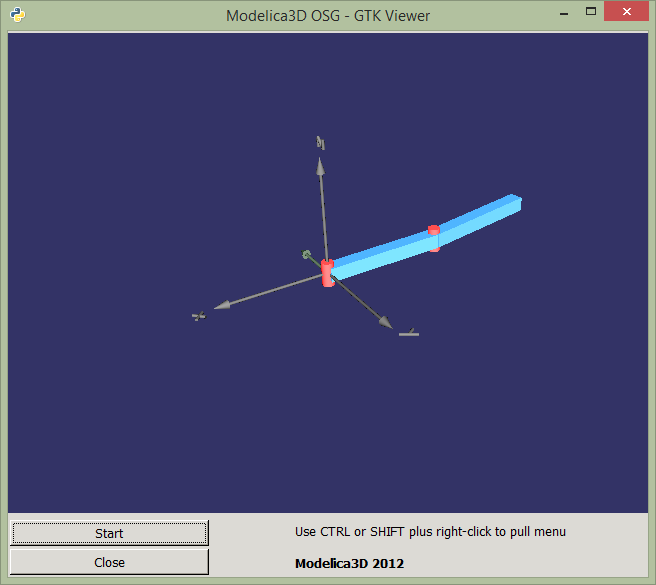Modelica3D¶
Modelica3D is a lightweight, platform independent 3D-visualisation library for Modelica. Read more about the Modelica3D library here.
Installing Modelica3D¶
Windows¶
In order to run Modelica3D on windows you need following softwares;
- Python – Install python from
http://www.python.org/download/. Python2.7.3 is recommended.
- PyGTK – Install GTK+ for python from
http://ftp.gnome.org/pub/GNOME/binaries/win32/pygtk/2.24/. Download the all-in-one package. Recommmended is pygtk-all-in-one-2.24.2.win32-py2.7.msi.
MacOS¶
On MacOS you can use the 3d visualization like this. Note that on your system the paths used here might vary. In one terminal type:
# start the dbus server (you only need to do this once)
sudo launchctl load -w /opt/openmodelica/Library/LaunchDaemons/org.freedesktop.dbus-system.plist
launchctl load -w /opt/openmodelica/Library/LaunchAgents/org.freedesktop.dbus-session.plist
# export python path
export PYTHONPATH=/opt/openmodelica/Library/Frameworks/Python.framework/Versions/2.7/lib/python2.7/site-packages:$PYTHONPATH
Running Modelica3D¶
Run the Modelica3D server by executing the dbus-server.py script located in your OpenModelica or Modelica3D installation, for example:
>>> "python " + getInstallationDirectoryPath() + "/lib/omlibrary-modelica3d/osg-gtk/dbus-server.py"
"python «OPENMODELICAHOME»/lib/omlibrary-modelica3d/osg-gtk/dbus-server.py"
Running this command in a command prompt will start the Modelica3D server and on success you should see the output:
Running dbus-server...
Now run the simulation. The following commands will load the Modelica3D library and the modified DoublePendulum example:
>>> loadModelica3D()
true
model DoublePendulum
extends Modelica.Mechanics.MultiBody.Examples.Elementary.DoublePendulum;
inner ModelicaServices.Modelica3D.Controller m3d_control;
end DoublePendulum;
Then simulate the DoublePendulum:
>>> simulate(DoublePendulum)
If everything goes fine a 3D visualization of DoublePendulum will pop-up.

Figure 71 3D visualization of DoublePendulum
To visualize any models from the MultiBody library you can use this script and change the extends to point to the model you want. Note that you will need to add visualisers to your model similarly to what Modelica.MultiBody library has. The documentation of the visualizers is available here.
model Visualize_MyModel
inner ModelicaServices.Modelica3D.Controller m3d_control;
extends MyModel;
end Visualize_MyModel;
>>> simulate(Visualize_MyModel)